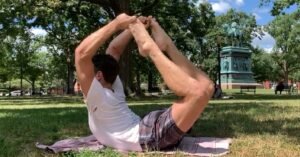Sometimes the Support is the Success
I got to watch a long-time practitioner nail her first straight-leg jump-through this week. Liz has been practicing for years with my dear friend and colleague Jen Rene before joining me shortly after the pandemic. She’s a gem.
Right after hearing the tell tale ‘swiff’ of a clean jump through, Liz and I locked eyes. “First one EVER,” she yelled.
Liz had attended my bodyweight transitions workshop at the Yoga Club just a few days prior to all of this, and I told her that I was going to tell everyone that fact. I’m joking around, of course. All credit goes to Liz. She had a few skills that were *this* close to coordinating, and she was able to find her thresholds, push pass them, and then leverage it into a breakthrough.
In systems thinking, Liz’s practice exemplifies how persistent effort and targeted adjustments (leverage points) eventually lead to significant changes (thresholds). Think of it like one of those arcade games where you drop a coin into a stack. Each coin you add is an effort, slowly building up the stack. Eventually, you place the coin that hits the tipping point, and all the coins come tumbling down—that’s the threshold. Similarly, Liz’s practice is a system where each element—strength, technique, alignment—interconnects and influences her overall performance. Over the years, Liz had been refining each element, gradually approaching the threshold where all components synergize to achieve the straight-leg jump-through.
The leverage point wasn’t just a change in hand positioning; it was a shift in mindset. Liz became curious about the potential of mastering this skill and developed a progression routine that led her to success in less than a week. This small but powerful change in her approach, in a system already primed for change, tipped her over the threshold, allowing her to execute the jump-through with ease. It’s a powerful reminder that in both yoga and life, persistent, mindful effort combined with strategic adjustments can lead to profound breakthroughs.
If you want to checkout the study guide and routines from the workshop, you can find the course at Ashtanga Tech.
More Support
I shared a little bit about my experience of the grieving process for the loss of my teacher over the last few weeks, and in doing so so much kind support. Over at Ashtanga Tech, my education and training platform, we have a lot of resources aimed at Yoga and Grief, both for practitioners and professionals. Here are just two items found in that study guide:
Learning to Grieve
Over the years, in working with people who are grieving, I’ve encouraged them first of all to surrender to the experience of their pain. To counteract our natural tendency to turn away from pain, we open to it as fully as possible and allow our hearts to break. We must take enough time to remember our losses… Rather than close ourselves to grief, it helps to realize that we only grieve for what we love. In allowing ourselves to grieve, we learn that the process is not cut and dried. It’s more like a spiral that brings us to a place of release, abates for a time, then continues on a deeper level. Often, when grieving, we think that it’s over, only to find ourselves swept away by another wave of intense feeling. For this reason, it’s important to be patient with the process, and not be in a hurry to put our grief behind us. – Ram Dass
The Buddha & The Mustard Seed
A woman was weeping with despair because her child had just died. She was so overcome by grief that she could not even grasp the truth that her child was dead. Clutching her dead child in her arms and with tear-filled eyes, she went to the Buddha and pleaded with him to help her find a miraculous medicine that would bring her child back to life. The Buddha told her to go into the village and to collect a mustard seed from each house that had not experienced the pain and suffering of having lost to death someone they loved. In the village she went house to house in search of the sacred seeds that would cure her child. Of course, in doing so she discovered that every house had experienced death, that all beings who were in relationship with others had experienced the loss of someone dear to them. She went to the Buddha and became his student. He instructed her to continue meditating on the impermanent nature of all phenomena. – Richard Freeman





